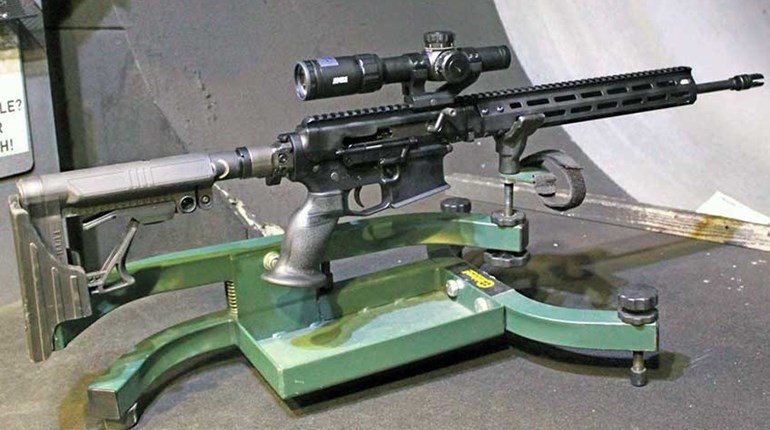** When you buy products through the links on our site, we may earn a commission that supports NRA's mission to protect, preserve and defend the Second Amendment. **

If we could point to the most misunderstood and overly-used phrase in the firearms world, it would probably be “mil-spec”. Mil-spec, which is short for “Military Specification” has gone from a boring set of quality standards to a marketing tool. So, what is MIL-SPEC and what does it really mean?
Let’s start with a simple definition: Mil-spec is “A document that describes the essential technical requirements for military-unique materiel or substantially modified commercial items. MIL-STD-961 covers the content and format for defense specifications.” In simple terms, mil-spec is a list of standards to which goods sold to the U.S. military must adhere. These standards might apply to truck tires, hats, t-shirts, and yes, firearms and ammunition. There is even a spec that specifies "Requirements for swim fins made of gum rubber for wear by military personnel for swimming purposes and for general utility." Exciting stuff.
In the munitions context, a standardized “spec” ensures that everyone is armed with firearms that are of equal quality and with interchangeable parts. This simplifies logistics and ensures a basic level of quality. In the marketing world, mil-spec has taken on a life of its own. It is promoted as some sort of gold standard for quality when, in fact, it is a floor rather than a ceiling. The military itself is rarely at the cutting edge of innovation, instead relying on private industry to meet the needs of the force. Just because a product meets the mil-spec doesn’t mean that is the best thing on the block.
Let’s take finishes, for example. The current mil-spec for barrel treatment is chrome-lining, a process that uses an electrical current to bind chrome to the inside of the bore. The process is designed to add durability and corrosion resistance, and has been used in this context since the M-16A—cutting edge technology from 60 years ago. Chrome-lining works fine, but it is probably not the best treatment process that money can buy. Ferritic nitrocarburizing, better known as black nitriding or melonite, provides similar levels of durability, better corrosion resistance and superior accuracy when compared to chrome. In addition, chrome lining only protects in the inside of the bore while nitriding protects both the inside and out. Nitriding doesn’t meet the mil-spec for the M-4’s barrel treatment, but it arguably produces a superior product.

If the military is good at anything it is testing. Soldiers can break just about anything and the military has extremely stringent and specific methods of testing potential weapons and gear to ensure that the level of quality that they specified has actually been delivered. The problem for civilians is that these testing standards aren’t always applicable to the general public. For example, the Navy has specifications that ensure weapons will function immediately after water immersion for over-the-beach operations. This is great if you’re a frogman, but probably not too important for the rest of us. Testing methods and standards can also be quite antiquated. I have been told, but cannot confirm, that the height for the army’s drop test for handguns was based on the distance from a mounted cavalry trooper to the ground.
Price is also a concern for the military. Defense budgets are what they are and the military must live within its means when choosing weapons. Vendors are often chosen because they are the lowest bidder, not because they offer the best product. Your own budget may afford you the ability to purchase firearms that are superior to those used by our armed forces, just as you can buy food that tastes far better than a mil-spec MRE (Meals Ready to Eat) or wear a suit that fits better than a dress uniform.
Finally, there is the case of products being advertised as mil-spec that do not actually meet that standard. During my research for this article, I was told by an industry insider that at least one AR-15 manufacturer advertises that its bolts are magnetic particle inspected (which is part of the mil-spec) when they are not. They may be great, but they are not mil-spec. The military has the resources to verify such claims while the rest of us have to take the manufacturers at their word.
If a firearm truly meets the military specification, we know that it satisfies a baseline standard for quality. If you’ve ever slept in a military sleeping bag, used a military backpack or hiked in military boots, you’ll probably agree that the issued items are rarely the best on the market. The same goes for firearms, which is something that we should all take into account when making our buying decisions. Just because a product is right for the military, doesn’t mean that it is the right choice for you.
Let’s start with a simple definition: Mil-spec is “A document that describes the essential technical requirements for military-unique materiel or substantially modified commercial items. MIL-STD-961 covers the content and format for defense specifications.” In simple terms, mil-spec is a list of standards to which goods sold to the U.S. military must adhere. These standards might apply to truck tires, hats, t-shirts, and yes, firearms and ammunition. There is even a spec that specifies "Requirements for swim fins made of gum rubber for wear by military personnel for swimming purposes and for general utility." Exciting stuff.
In the munitions context, a standardized “spec” ensures that everyone is armed with firearms that are of equal quality and with interchangeable parts. This simplifies logistics and ensures a basic level of quality. In the marketing world, mil-spec has taken on a life of its own. It is promoted as some sort of gold standard for quality when, in fact, it is a floor rather than a ceiling. The military itself is rarely at the cutting edge of innovation, instead relying on private industry to meet the needs of the force. Just because a product meets the mil-spec doesn’t mean that is the best thing on the block.
Let’s take finishes, for example. The current mil-spec for barrel treatment is chrome-lining, a process that uses an electrical current to bind chrome to the inside of the bore. The process is designed to add durability and corrosion resistance, and has been used in this context since the M-16A—cutting edge technology from 60 years ago. Chrome-lining works fine, but it is probably not the best treatment process that money can buy. Ferritic nitrocarburizing, better known as black nitriding or melonite, provides similar levels of durability, better corrosion resistance and superior accuracy when compared to chrome. In addition, chrome lining only protects in the inside of the bore while nitriding protects both the inside and out. Nitriding doesn’t meet the mil-spec for the M-4’s barrel treatment, but it arguably produces a superior product.

If the military is good at anything it is testing. Soldiers can break just about anything and the military has extremely stringent and specific methods of testing potential weapons and gear to ensure that the level of quality that they specified has actually been delivered. The problem for civilians is that these testing standards aren’t always applicable to the general public. For example, the Navy has specifications that ensure weapons will function immediately after water immersion for over-the-beach operations. This is great if you’re a frogman, but probably not too important for the rest of us. Testing methods and standards can also be quite antiquated. I have been told, but cannot confirm, that the height for the army’s drop test for handguns was based on the distance from a mounted cavalry trooper to the ground.
Price is also a concern for the military. Defense budgets are what they are and the military must live within its means when choosing weapons. Vendors are often chosen because they are the lowest bidder, not because they offer the best product. Your own budget may afford you the ability to purchase firearms that are superior to those used by our armed forces, just as you can buy food that tastes far better than a mil-spec MRE (Meals Ready to Eat) or wear a suit that fits better than a dress uniform.
Finally, there is the case of products being advertised as mil-spec that do not actually meet that standard. During my research for this article, I was told by an industry insider that at least one AR-15 manufacturer advertises that its bolts are magnetic particle inspected (which is part of the mil-spec) when they are not. They may be great, but they are not mil-spec. The military has the resources to verify such claims while the rest of us have to take the manufacturers at their word.
If a firearm truly meets the military specification, we know that it satisfies a baseline standard for quality. If you’ve ever slept in a military sleeping bag, used a military backpack or hiked in military boots, you’ll probably agree that the issued items are rarely the best on the market. The same goes for firearms, which is something that we should all take into account when making our buying decisions. Just because a product is right for the military, doesn’t mean that it is the right choice for you.






































